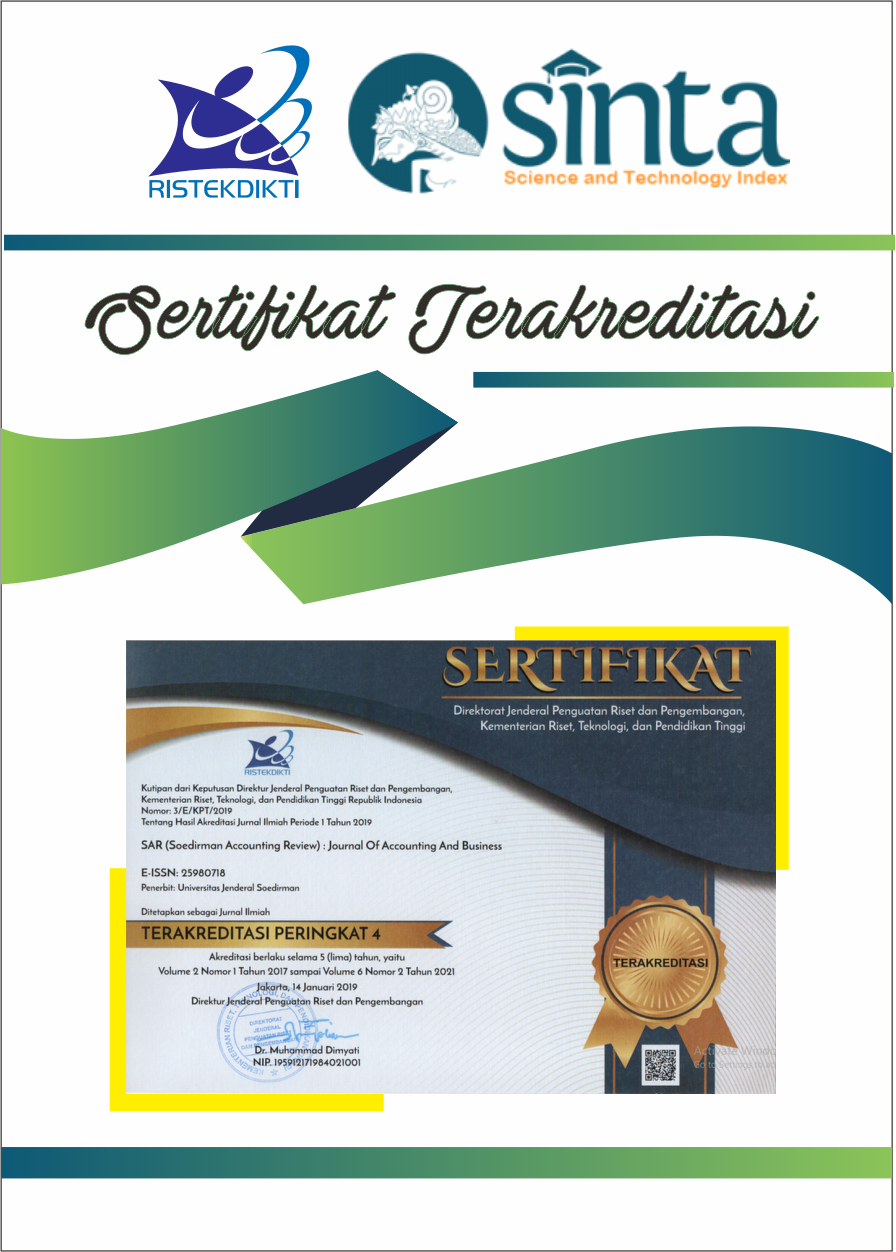Hubungan CEO Overconfidence dengan Penghindaran Pajak
Abstract
The purpose of this study was to analyze the relationship between CEO overconfidence and tax avoidance. This study uses overinvestment to measure the level of overconfidence of a company CEO. The tax avoidance is measured by the Effective Tax Ratio (ETR). This study uses 567 observations from non-financial companies listed on the Indonesia Stock Exchange (IDX) for the 2014-2018 period and uses STATA 14.0 software to analyze the data. The results of the analysis show that CEO overconfidence has a positive relationship with tax avoidance. Companies that have CEO overconfidence tend to be involved in regulating corporate taxes which leads to tax avoidance activities. Thus, this study succeeded in proving that the more overconfident a CEO is, the more aggressive the tax avoidance will be.
References
Bhandari, G., & Deaves, R. (2010). The Demographics of Overconfidence The Demographics of Overconfidence Gokul Bhandari and Richard Deaves. December 2014, 37–41. https://doi.org/10.1207/s15427579jpfm0701
Brown, R., & Sarma, N. (2007). CEO overconfidence, CEO dominance and corporate acquisitions. Journal of Economics and Business, 59, 358–379. https://doi.org/10.1016/j.jeconbus.2007.04.002
Cahyono, D. D., Andini, R., & Raharjo, K. (2016). Pengaruh Komite Audir, Kepemilikan Institusional, Dewan Komissaris, Ukuran Perusahaan (Size), Leverage (DER), dan Profitabilitas (ROA) Terhadap Tindakan Penghindaran Pajak (Tax Avoidance) Pada Perusahaan Perbankan yang Listing BEI Periode Tahun 2011-2013. Journal of Accounting, 2(2).
Chyz, J. A., Gaertner, F. B., Kausar, A., & Watson, L. (2019). Overconfidence and Corporate Tax Policy. Review of Accounting Studies, 24(3), 1114–1145. https://doi.org/10.1007/s11142-019-09494-z
Dyreng, S. D., Hanlon, M., & Maydew, E. L. (2010). The Effects of Executives on Corporate Tax Avoidance. The Accounting Review, 85(4), 1163–1189. https://doi.org/10.2308/accr.2010.85.4.1163
Goel, A. M., & Thakor, A. V. (2008). Overconfidence , CEO Selection ,. LXIII(6).
Hambrick, D. C., & Mason, P. A. (1984). Echelons : of Reflection The Its Organization as Top a. 9(2), 193–206.
Hambrick, D. C., Mason, P. A., & Mason, P. A. (1984). Echelons : of Reflection The Its Organization as Top a. 9(2), 193–206.
Hanlon, M., & Heitzman, S. (2010). A review of tax research $. Journal of Accounting and Economics, 50(2–3), 127–178. https://doi.org/10.1016/j.jacceco.2010.09.002
Hariyanto, I. T., & Suhardianto, N. (2018). Tata Kelola Perusahaan Dan Variabilitas Laba. EKUITAS (Jurnal Ekonomi Dan Keuangan), 2(2). https://doi.org/10.24034/j25485024.y2018.v2.i2.3943
He, Y., Chen, C., & Hu, Y. (2018). SC. In Research in International Business and Finance. Elsevier B.V. https://doi.org/10.1016/j.ribaf.2018.09.010
Hirshleifer, D., Low, A., & Teoh, S. H. (2012). Are Overconfident CEOs Better Innovators? Journal of Finance, 67(4), 1457–1498. https://doi.org/10.1111/j.1540-6261.2012.01753.x
Hoseini, M., & Gerayli, M. S. (2019). Demographic characteristics of the board of directors ’ structure and tax avoidance Evidence from Tehran Stock Exchange. 46(2), 199–212. https://doi.org/10.1108/IJSE-11-2017-0507
Hribar, P., & Yang, H. (2016). CEO Overconfidence and Management Forecasting. 33(1), 204–227. https://doi.org/10.1111/1911-3846.12144
Hsieh, T., Wang, Z., & Demirkan, S. (2018). Journal of Accounting and Public Policy Overcon fi dence and tax avoidance : The role of CEO and CFO interaction. 37, 241–253. https://doi.org/10.1016/j.jaccpubpol.2018.04.004
Kartana, I. W., Agung, G., & Wulandari, S. (2018). Pengaruh Karakteristik Eksekutif, Karakteristik Perusahaan, dan Corpporate Governance terhadap Tax Avoidance. 10(1), 1–13.
Kubick, T. R., & Lockhart, G. B. (2017). Overconfidence , CEO Awards, and Corporate Tax Aggressiveness. https://doi.org/10.1111/jbfa.12237
Maharani, I. G. A. C., & Suardana, K. A. (2014). Pengaruh Corporate Governance, Profitabilitas, dan Karakteristik Eksekutif Pada Tax Avoidance Perusahaan Manufaktur. 2, 525–539.
Malmendier, U., & Tate, G. (2005). CEO Overconfidence and Corporate Investment. LX(6).
Mayberry, M. (2012). Tax Avoidance and Investment: Distinguishing the Effects of Capital Rationing and Overinvestment. Texas A&M University, December.
Pajak Penghasilan Pasal 4 ayat (2), https://www.pajak.go.id/ diakses tanggal 19 Mei 2020
Schrand, C. M., & Zechman, S. L. (2011). Executive Overconfidence and the Slippery Slope to Financial Misreporting.
Suandy, Erly. 2016. Perencanaan Pajak. Jakarta: Salemba Empat
Sudana, I Made. 2015. Manajemen Keuangan Perusahaan Edisi 2. Jakarta: Erlangga
Sumunar, K. I., Jannah, L., & Aulia, D. (2019). CEO overconfidence , tax avoidance , and education foundation. Jurnal Akuntansi Dan Auditing Indonesia, 23(2).
Ting, I. wei K., Lean, H. H., Kweh, L. Q., & Azizan, N. A. (2016). Article information : International Journal of Managerial Finance, 12(1), 4–24. https://doi.org/10.1108/IJMF-04-2014-0041
Undang-Undang Nomor 36 Tahun 2008 tentang Pajak Penghasilan, https://www.pajak.go.id/id/undang-undang-nomor-36-tahun-2008 diakses pada tanggal 19 Mei 2020












1.png)
.png)





.jpg)





